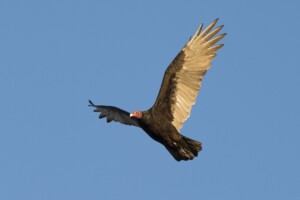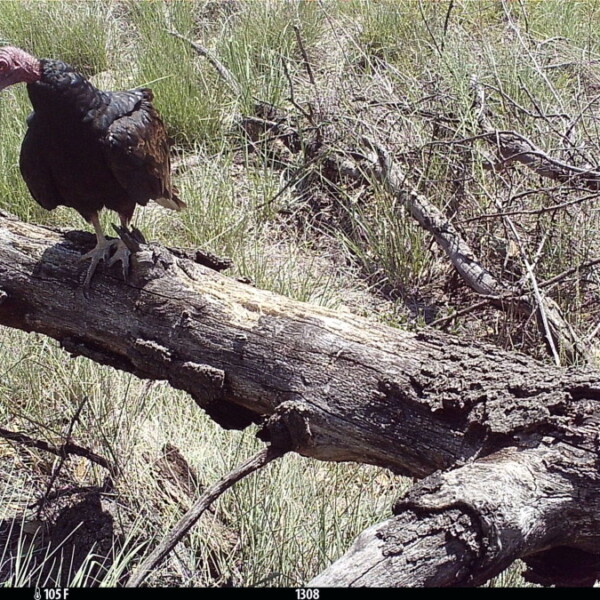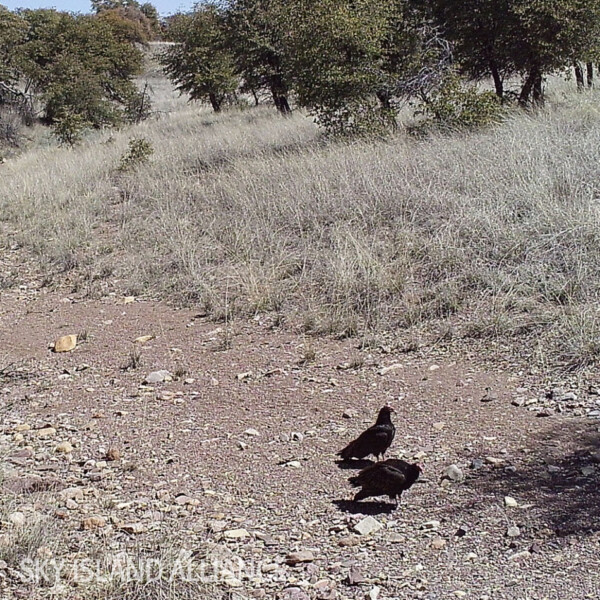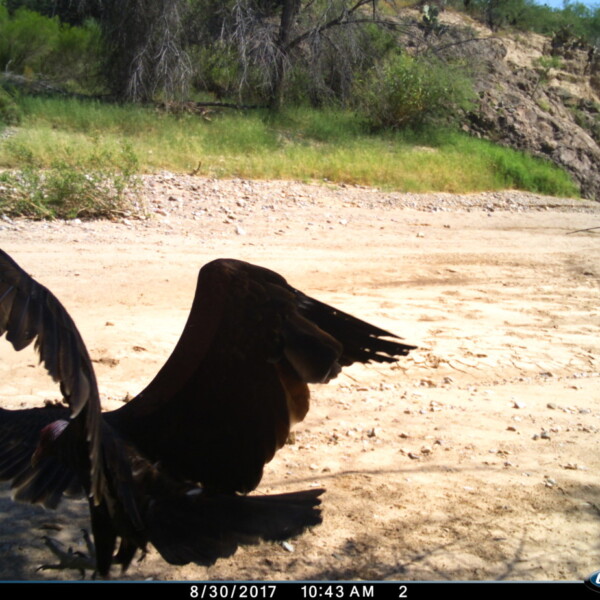Our bird of focus for this week’s creature feature is the turkey vulture (Cathartes aura). Despite the name, turkey vultures are more vulture than turkey—they belong to the vulture family—and are commonly seen across our Sky Island region; in fact, they are one of the 70+ species we’ve detected through our Border Wildlife Study.
Keep reading to learn more about these birds and how to spot them in the wild.
Description:
Turkey vultures are long-winged (>6 feet) birds with dark brown feathers and a featherless, pink-ish red head that gives them a turkey-like appearance. At a distance, turkey vultures look entirely black, and from underneath, they can look two-toned as their darker feathers contrast against their flight feathers. Males and females are almost identical in appearance.
There are six species of turkey vultures currently found across the Americas. Three of these species—including Cathartes aura aura, the one we see most often in the Sky Island region—are found in North America and three are found throughout Central and South America.
Habitat:
Turkey vultures can find preferred habitat all across North America. They prefer rocky or wooded areas for nesting but are not particularly picky about their habitats for foraging or breeding.
Turkey vultures are also migratory. In the winter, they live in Mexico and parts of the southern United States. In the spring, they migrate north into various parts of the American west, midwest, southwest, and northeast, where they thrive until the weather changes and sends them south again.
As global temperatures increase, researchers predict turkey vultures will gain more habitat in upcoming decades, thus allowing the species to spend more time in the U.S. instead of migrating south for the winter (source: Tucson Audubon).
 Behavior:
Behavior:
From March to November, turkey vultures roost, mate, and forage in the Sky Islands. You can often find them surfing on thermals in the evenings before sunset, which they use to achieve a better vantage point for foraging.
Fun fact: In the Mule Mountains, one of our Sky Island ranges, residents of the town of Bisbee celebrate the coming of spring with a “Return of the Turkey Vultures” parade. This happens every year in March.
Turkey vultures forage separately but roost together as a community. They generally lay two eggs during breeding season, which is between March and June. The parents take turns incubating the eggs for five weeks and then, when their offspring hatch, they also take turns feeding the young. Turkey vultures fledge around 10 weeks of age.
Turkey vultures can live an average of 10 years in the wild—longer in captivity. While they have very few natural predators, turkey vultures can protect themselves and their young by vomiting up stomach acid, a foul–smelling substance that helps deter attackers.
When hunting, turkey vultures will watch other scavenger birds to see if they’re drawn to carrion. They also forage for dead by smell, an unusual trait for birds.
Diet:
As foragers, turkey vultures play an important role in our ecosystem. They eat carrion (dead animals) as well as some live fish or insects. While hunting, turkey vultures will watch other scavenger birds to see if they’ve spotted a meal. They also search for carrion by using their highly developed sense of smell, an unusual trait for birds.
Status:
Turkey vulture populations and their habitats are currently stable.
Identification Tips:
Here are some traits to look for when identifying a turkey vulture:
- From underneath: black body with light grey feathers along the wings
- Slight v-shape when riding on thermals, very few wing flaps
- “Finger-like” feathers at the very tips of the wings
- Red or pink skin on head, no feathers
- Dark brown or black feathers around the neck
- Hooked, pale white bill
- 69-inch (>6 ft) wingspan
On the ground, a turkey vulture can resemble a wild turkey due to its coloring, size, and bald red head. What are the primary differences? Wild turkeys have white, grey, and brown feathers, a fleshy wattle/caruncle under their bill, and a beard feather that hangs down past their breast.




